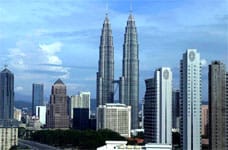High oil prices and accelerating regional growth are transforming the prospects of Asias new emerging markets.

|
As Tim Condon, chief economist, Asia-Pacific, at ING in Singapore, notes, Asia is largely going to see more of the same. And while growth will remain below the potential for the regionfor a number of reasons including the ongoing legacy of the Asia financial crisis in 1997-1998 and the massive savings surplus in most Asian countriesit will remain impressive by global standards.
A rate of 6.9% growth is predicted by the ADB for East Asia, much of which comes from the expected 9.2% growth of China. And while South Asia is likewise dominated by the 6.8% growth of India, Pakistan is expected to achieve its fastest growth in more than 20 years while Bangladesh, whose cotton sector had been assumed to be vulnerable to the might of China following its WTO entry, is growing steadily.
In Southeast Asia, economic growth is expected to pick up from 2005s 5% to 5.4% as the factors that held expansion in checkincluding the after-effects of the tsunamiduring 2005 recede. The global electronics sector should also bottom out and begin a new expansionary phase later this year, which would help lift exports and growth in Malaysia and the Philippines, according to the ADB.
One of the forgotten nations of Southeast Asia, Laos, which recently celebrated 30 years of communist government following the removal of a US-backed government, is on course for robust growth of 8%, compared to 7.2% in 2005. To be sure, peasant farming still accounts for half the countrys GDP and 80% of employment, but hydropower, tourism and mining are gaining in economic importance.
However, it is Central Asia, especially Azerbaijan and Kazakhstan, that will be among the hottest regions in the world in 2006. A huge increase in oil and gas production in the region, which a decade ago was a newly independent, poverty-stricken, Soviet-style backwater, is changing the character of these nations dramatically and seeing them courted assiduously by the regional powers of Russia and China, which are eager to gain access to energy resources.
Five years ago the suggestion that companies from Kazakhstan would be borrowers in the international capital markets and that others from the country would be lining up to list in London would have been dismissed as absurd. Yet that is the situation the country, which re-elected its autocratic president Nursultan Nazarbayev by a dubious landslide majority in December, finds itself in.
Nazarbayev is in the process of building a new capital city for Kazakhstan in Astana, one of the most inhospitable places on the planet. But while he has many detractors and opponents who allege his regime is corrupt, there are few who doubt this act of megalomania is unachievable given that the country, which has only 15 million people, expects to be one of the worlds top-10 oil producers within a decade. Infrastructure and service-related business are also growing apace in Kazakhstan as wealth trickles down through the population.
Kazakhstans much smaller neighbor across the Caspian Sea, Azerbaijan, poised for even more impressive growth of 22% in 2006 from the 17% achieved in 2005, has tripled in size in the past decade, according to the ADB. Azerbaijan and Kazakhstans growth has been buoyed by oil prices, which have risen 75% during 2005 and show little sign of falling substantially, given the military tensions pervading the Middle East and Gulf region and the myriad natural disasters that have befallen oil-producing nations in 2005.
|
Trouble Ahead? |
||
Assessing the risks to Asia in 2006 is difficult. While an event such as a bird flu pandemic clearly would be devastating to the region, it is also impossible to quantify, according to INGs Condon. Its as tough as assessing the reality of the risk from North Korea. What is more likely is that the threats to Asia will come from outside the region. The Philippines and Indonesia are vulnerable to emerging market contagion if, for example, Brazil found itself in trouble. But domestically most of Asia looks stable: There is little political risk, and Asia overall is running a current account surplus.
High oil prices represent one potential external threat to Asias economic growth. Signs of strain are beginning to show. Failure to adjust could put prospects at risk, says Ifzal Ali, chief economist at the ADB in Manila. Even net oil exporters such as Kazakhstan, Papua New Guinea and Vietnam face challenges when oil prices soar. But Condon at ING believes that most economies in the region can cope with the current price of oil. What is harmful to consumer psychology is not the price level but the rate of change, which leads to adjustments in consumer behavior, he says. It has shocked people and has dampened domestic demand in many markets, but it does not appear to be fundamentally detrimental to most Asian economies at this level. That is largely because most economies, and individuals, are continuing to see solid income growth, which outweighs the increase in oil prices. Condon notes that much of the region is in the process of dismantling oil price controls and removing subsidies from energy products. Thailand and Indonesia have done so, and while the Philippines still has some control, which resulted in a delay in passing price changes on to consumers, they are ultimately passed on, he says. In many ways, such actions are one of the fortunate outcomes of the spike in oil prices in 2005. Another external threat to Asia could be a sudden loss of confidence in the US dollarpredicted by some as the US twin deficits continue to escalate. It could result in a sharp fall in the value of the dollar, which could spill over into financial markets and the real economy. But Condon notes that the bond market believes that the fiscal deficit has peaked and also suggests the 10 consecutive quarters of growth in the US economy reduce the chances of a sudden slide in the dollar. |
Stars of the Future
Analysts believe the huge savings surplus in many Asian countries has had the effect of raising asset prices in many economies. One of the outcomes of this saving surplus is that domestic demand will remain subdued, but it also has beneficial effects for Asian asset prices, Condon says. Given the general benign outlook for Asia in 2006, investors will probably be best rewarded for buying the riskiest assets. High prices tend to make those countries, such as Indonesia, which are relatively high risk, the best prospects for the coming years, he says.
David Fernandez, head of emerging Asia economic and sovereign research at JPMorgan in Singapore, agreesfor different reasonsthat Indonesia could be the country to watch in 2006. Indonesia was the most volatile country in Asia in 2005 and for a while invoked memories of the Asian crisis as the rupiah hit a four-year low on August 30. But in the second half of the year there was a remarkable turnaround in terms of policy resolve, and Bank Indonesia has been on the warpath in its efforts to cap inflationincreasing the benchmark rate for the sixth time in four months in early December, he says.
Fernandez believes 2006 could see a significantly stronger rupiah and a shaper decline in interest rates as the economy adjusts to the rate rises in 2005. Indonesia had the worst-performing currency and local bond market in 2005 and a lackluster equity market, notes Fernandez. And while its always tempting to pick the dog of the market to be the best performer the following year, there is a strong rationale for believing it might be so with Indonesia in 2006 for FX and rates, given the policy impetus.
The hottest market in 2005, South Korea, could also be one of the hottest in 2006. The benchmark equity index, the Kospi, gained around 45% in 2005 and recently hit an all-time record high while the Korean won remained stable throughout the year. Part of the reason for the gains is last years solid, if not exciting, economic growth of around 3.7%, according to the Bank of Korea. But much of the Kospi performance can be attributed to structural trends such as the increase in equity investment by pension funds.
Fernandez says that the Kospi performance also owes a lot to the self-belief of Koreans. They believe in the economic growth story againand are spending moreafter years of consumer depression following the bursting of the consumer credit bubble, he says. It is no coincidence that Korea performed well in 2005 while Taiwan did not. Market performance and economic growth in Asia will become increasingly reliant on domestic consumption rather than export-driven growth, and Korea has done well to recognize the fact.
Joachim Bamrud




